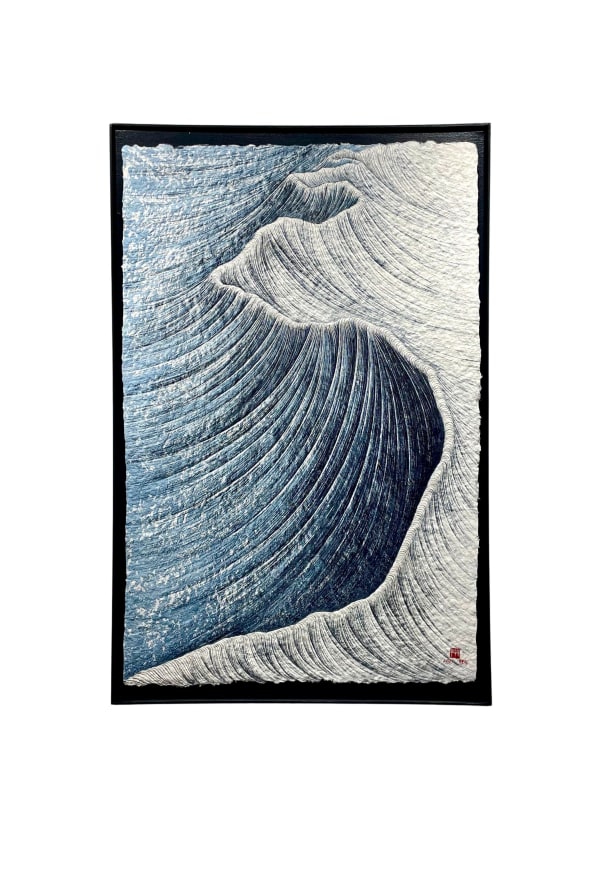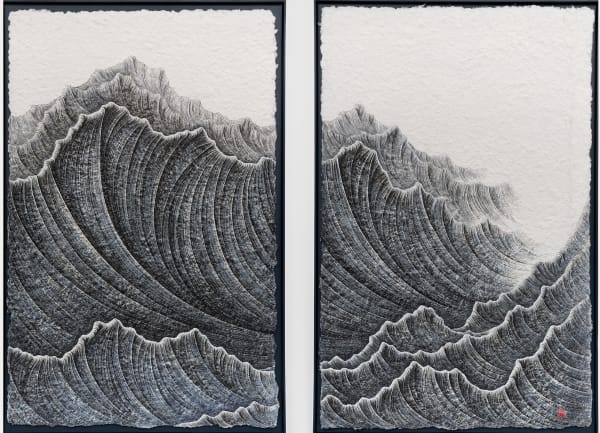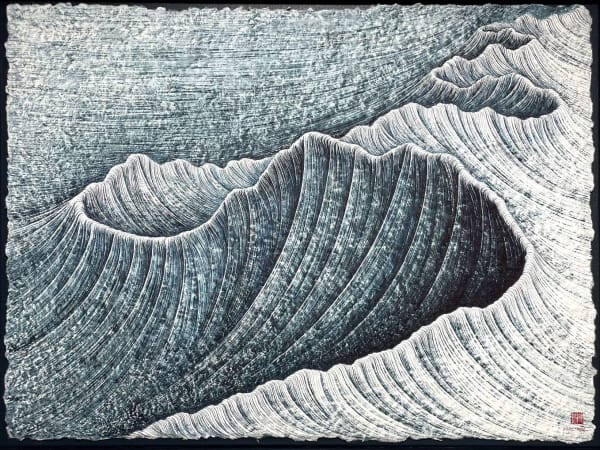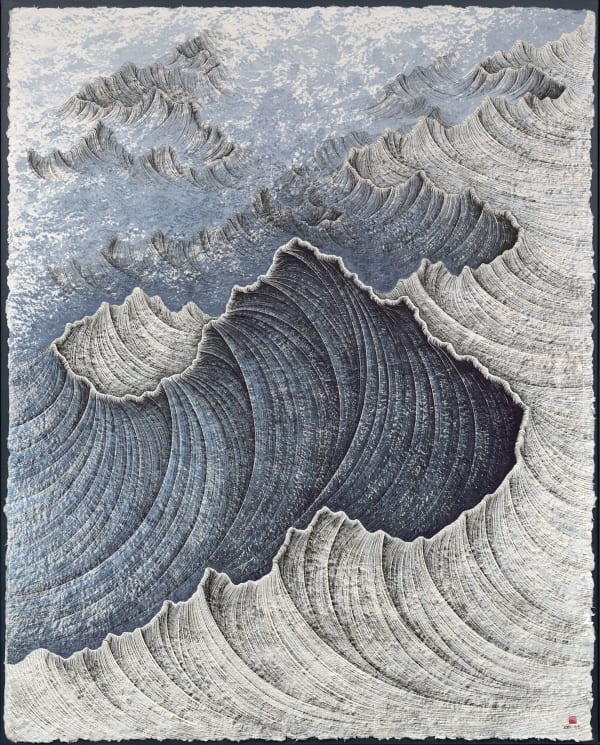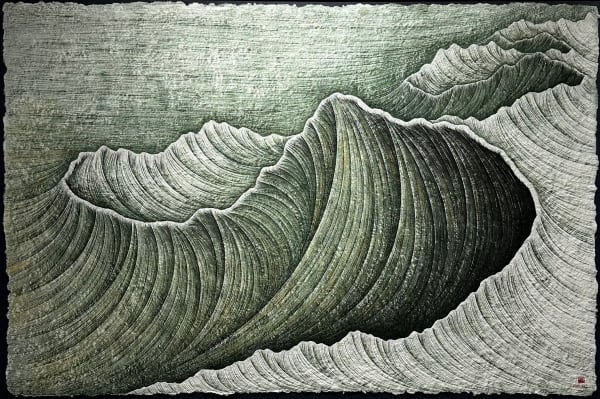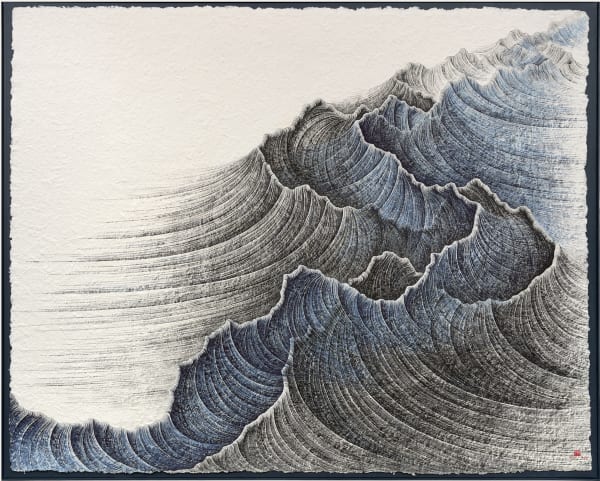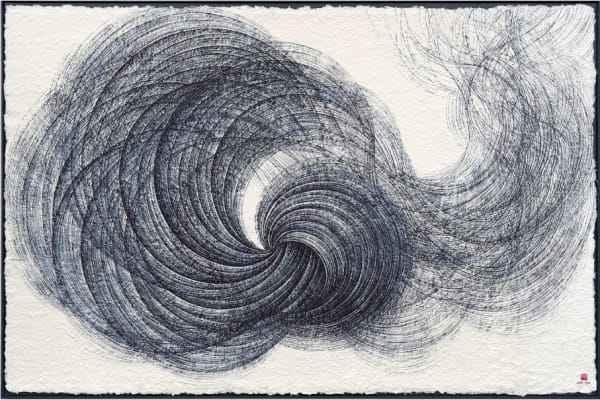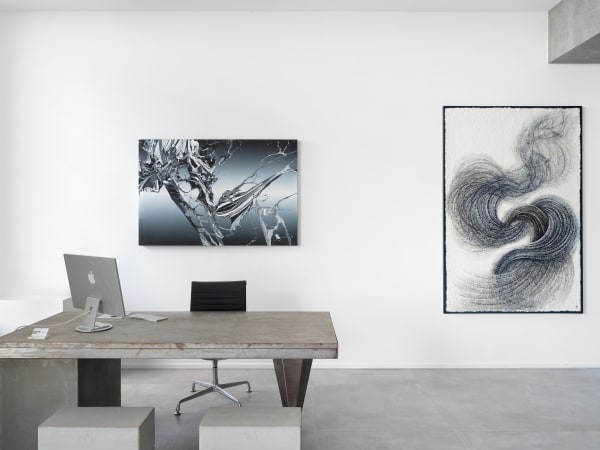LEE HYUN-JOUNG SOUTH-KOREA, 1972
A JOURNEY THROUGH MEMORY AND TIME
Born in 1972 in Seoul, South Korea, Lee Hyun Joung is an artist whose work explores memory, spirituality, and the passage of time. Her works, which she calls "paths," are more than just lines; they represent lived moments, both past and present, inviting viewers into a deeply introspective experience.
After studying Fine Arts at Sejong University in Seoul, Lee Hyun Joung moved to Paris to train in goldsmithing, a craft that deeply influences her artistic approach. This dual heritage shapes her unique artistic language, seamlessly merging Korean traditions with contemporary aesthetics. She works with traditional Korean materials, including Hanji paper and black ink (Muk), creating reliefs that add depth and texture to her compositions. Her experience in jewelry-making is reflected in the meticulous details of some of her works.
For over twenty years, Lee Hyun Joung has exhibited across Europe, South Korea, and China, participating in numerous solo and group exhibitions. In 2017, she was awarded the Taylor Prize at Art Capital in the Grand Palais in Paris, recognizing her talent and contribution to the art world. Her works have been showcased in prestigious venues, including the Taylor Foundation in Paris, Galerie Plexus in Montreux, and The Columns Gallery in Seoul. In 2024, she was honored with the "Ridge Lines" exhibition at Galerie Sept in Brussels, celebrating six years of collaboration between the artist and the gallery.
Lee Hyun Joung’s creative process is deeply meditative. Often working on the floor, she lets the natural relief of Hanji paper emerge, guiding her brush to create linear patterns that either accentuate or obscure these reliefs. Each line reflects a day or a moment lived, and the perception of her work depends on the viewer's inner world and imagination, making every encounter with her art a unique and evolving experience.
Beyond her exhibitions, Lee Hyun Joung has participated in international art fairs, including Asia Now Art Fair in Paris and Art Busan in South Korea. Her works are also part of private collections, including the Cernuschi Museum in Paris since December 2024. Her commitment to art, combined with her ability to merge traditional techniques with a contemporary vision, makes her a key figure in today’s contemporary art scene.
-
 Lee Hyun-JoungChemin Bleu130 x 100 x 3.5 cm
Lee Hyun-JoungChemin Bleu130 x 100 x 3.5 cm -
 Lee Hyun-JoungChemin Bleu - Artist Personal Collection100 x 70 x 3 cm
Lee Hyun-JoungChemin Bleu - Artist Personal Collection100 x 70 x 3 cm -
 Lee Hyun-JoungChemin Bleu 150 x 50 cm150 x 50 cm
Lee Hyun-JoungChemin Bleu 150 x 50 cm150 x 50 cm -
 Lee Hyun-JoungChemin Contemplation90 x 60 x 3 cm
Lee Hyun-JoungChemin Contemplation90 x 60 x 3 cm -
 Lee Hyun-JoungChemin Infini Green130 x 90 cm
Lee Hyun-JoungChemin Infini Green130 x 90 cm -
 Lee Hyun-JoungChemins de Vie 1150 x 50 x 3.5 cm
Lee Hyun-JoungChemins de Vie 1150 x 50 x 3.5 cm -
 Lee Hyun-JoungChemins de Vie 2150 x 50 x 3.5 cm
Lee Hyun-JoungChemins de Vie 2150 x 50 x 3.5 cm -
 Lee Hyun-JoungCollision - Art On Paper65 x 93 x 3.5 cm
Lee Hyun-JoungCollision - Art On Paper65 x 93 x 3.5 cm -
 Lee Hyun-JoungCollision - Art On Paper100 x 65 x 3.5 cm
Lee Hyun-JoungCollision - Art On Paper100 x 65 x 3.5 cm -
 Lee Hyun-JoungCollission - 2024100 x 130 x 3.5 cm
Lee Hyun-JoungCollission - 2024100 x 130 x 3.5 cm -
 Lee Hyun-JoungContemplation50 x 80 x 3 cm
Lee Hyun-JoungContemplation50 x 80 x 3 cm -
 Lee Hyun-JoungContemplation - Art On Paper130 x 100 x 3.5 cm
Lee Hyun-JoungContemplation - Art On Paper130 x 100 x 3.5 cm -
 Lee Hyun-JoungContemplation 1 2023130 x 100 x 3.5 cm
Lee Hyun-JoungContemplation 1 2023130 x 100 x 3.5 cm -
 Lee Hyun-JoungContemplation 2 2023130 x 100 x 3.5 cm
Lee Hyun-JoungContemplation 2 2023130 x 100 x 3.5 cm -
 Lee Hyun-JoungContemplation 2024195 x 130 x 3.5 cm
Lee Hyun-JoungContemplation 2024195 x 130 x 3.5 cm -
 Lee Hyun-JoungContemplation Gris100 x 130 x 4 cm
Lee Hyun-JoungContemplation Gris100 x 130 x 4 cm -
 Lee Hyun-JoungContemplation Triptyque - Art On Paper162 x 100 x 3.5 cm (Triptyque)
Lee Hyun-JoungContemplation Triptyque - Art On Paper162 x 100 x 3.5 cm (Triptyque) -
 Lee Hyun-JoungContemplation Vert80 x 147 x 3.5 cm
Lee Hyun-JoungContemplation Vert80 x 147 x 3.5 cm -
 Lee Hyun-JoungGrand Chemin160 × 120 cm
Lee Hyun-JoungGrand Chemin160 × 120 cm -
 Lee Hyun-JoungGrand Contemplation120 x 160 cm
Lee Hyun-JoungGrand Contemplation120 x 160 cm -
 Lee Hyun-JoungLes Chemins - Art On Paper117 x 74 x 3.5 cm
Lee Hyun-JoungLes Chemins - Art On Paper117 x 74 x 3.5 cm -
 Lee Hyun-JoungLes Chemins 2023150 x 50 x 4 cm
Lee Hyun-JoungLes Chemins 2023150 x 50 x 4 cm -
 Lee Hyun-JoungLes Failles117 x 74 x 3.5 cm
Lee Hyun-JoungLes Failles117 x 74 x 3.5 cm -
 Lee Hyun-JoungLes Failles - Art On Paper150 x 50 x 3.5 cm
Lee Hyun-JoungLes Failles - Art On Paper150 x 50 x 3.5 cm -
 Lee Hyun-JoungLes Failles - Art On Paper130 x 162 x 3.5 cm
Lee Hyun-JoungLes Failles - Art On Paper130 x 162 x 3.5 cm -
 Lee Hyun-JoungMemoire du Vent160 x 115 x 4 cm
Lee Hyun-JoungMemoire du Vent160 x 115 x 4 cm -
 Lee Hyun-JoungMemoire du vent97 x 147 x 3,5 cm
Lee Hyun-JoungMemoire du vent97 x 147 x 3,5 cm -
 Lee Hyun-JoungMemoire du vent130 x 195 x 3,5 cm
Lee Hyun-JoungMemoire du vent130 x 195 x 3,5 cm -
 Lee Hyun-JoungMemoire du vent195 x 130 x 3,5 cm
Lee Hyun-JoungMemoire du vent195 x 130 x 3,5 cm -
 Lee Hyun-JoungMemoire du vent130 x 100 x 3,5 cm
Lee Hyun-JoungMemoire du vent130 x 100 x 3,5 cm -
 Lee Hyun-JoungPath117 x 80 x 3.5 cm
Lee Hyun-JoungPath117 x 80 x 3.5 cm -
 Lee Hyun-JoungSilence100 x 130 x 3.5 cm
Lee Hyun-JoungSilence100 x 130 x 3.5 cm -
 Lee Hyun-JoungSymphonie en Trois Mouvements340 x 100 cm - Tryptique
Lee Hyun-JoungSymphonie en Trois Mouvements340 x 100 cm - Tryptique
-

Lee Hyun Joung Solo Show - Art On Paper
Le quotidien de l'art , October 15, 2024 -

Covering Ridge Lines
The Neighbor , May 1, 2024 -

7 Questions for Artist Lee Hyun Joung on Mining Her Dual Heritage for Inspiration
Artnet, April 1, 2024 -

Densely Heaving Lines Meet at Mountainous Junctures in Lee Hyun Joung's paintings
Colossal , March 25, 2024 -

Mémoires du pays du matin calme
ACUMEN , February 16, 2024
-

PAUSE
KATRIN FRIDRIKS - LEE HYUN JOUNG 26 November 2024 - 8 February 2025REFLECTING ON NATURE, TIME, AND SELF WITH LEE HYUN JOUNG & KATRIN FRIDRIKS In a captivating dialogue between the raw energy of nature and introspective meditation, the works of Katrin...Lees meer -

ART ON PAPER
LEE HYUN JOUNG SOLO SHOW 3 October - 10 November 2024The drawn line follows the meanders of thought and the course of life. It is from this dialogue between the gesture, the material, and the thought of the painter in...Lees meer -

PARALLEL REALITIES
LEE HYUN JOUNG - JOHANN ALEXIS 18 July - 18 September 2024Galerie Sept Brussels is delighted to announce its very first themed exhibition during the summer holidays, 'Parallel Realities.' This duo show presents two artists from very different backgrounds yet with...Lees meer -

RIDGE LINES
LEE HYUN JOUNG SOLO SHOW 4 April - 15 May 2024We will celebrate 6 years of friendship and the anniversary of our gallery in Brussels with one of our first artists, the talented - Lee Hyun Joung. Her vision resonate...Lees meer




